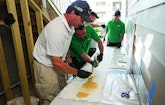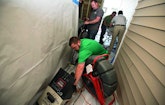
Interested in Cleaning?
Get Cleaning articles, news and videos right in your inbox! Sign up now.
Cleaning + Get AlertsAt O’Connor Plumbing, technicians never have to utter those dreaded words, which is a primary reason why the company’s drain cleaning efforts have grown from sideline status to thriving profit center in less than three years.
The Germantown, Maryland-based company has used a three-pronged strategy to achieve rapid growth in its drain division: invest heavily in technologies that boost productivity and streamline processes and, in doing so, improve customer service; implement strict quality-control regimens to reduce profit-killing callbacks; and focus on long-term preventive maintenance contracts that offer more consistent cash flow and better control over work schedules.
The results speak for themselves, says Kevin Walker, drain division manager. Three years ago, the drain cleaning end of O’Connor Plumbing’s business was in its infancy. Today, the division runs nine service trucks, employs 17 people and contributes about 33 percent of the company’s annual total gross revenue. Most of the company’s drain work is commercial; the balance is residential.
The company hired Walker in October 2012 to quarterback a full-fledged expansion into drain cleaning, attracted by his 13 years of industry experience. “There was no real emphasis on drain cleaning at the time,” Walker explains. Most of the company’s work stemmed from commercial plumbing service and construction, such as apartment building renovations and tenant fit-outs (office-building renovations). “But there was strong demand for quality drain cleaning,” he adds.
Good equipment is critical
Expanding services required a considerable investment in new equipment. The company strongly believes in spending money to make money; in other words, investing in quality, technologically advanced equipment pays dividends down the road in terms of reduced downtime and greater productivity — and happier customers, too.
The company currently runs five trailer-mounted water jetters made by US Jetting (ranging from 18 to 25 gpm at 4,000 psi). And the company plans to buy another one soon, Walker notes. The company also owns RIDGID pipeline inspection cameras of various sizes for inspecting drains ranging from 2 to 6 inches in diameter. In addition, the company owns RIDGID K-50 sectional drain cleaning machines for unclogging small drains and RIDGID K-1500 sectional drain cleaning machines for tackling larger lines. The company prefers Warthog nozzles made by StoneAge, and also owns Power Smoker 2 smoke-testing machines made by Hurco Technologies.
The division’s service fleet features six Chevrolet Express 2500 box cargo vans. Each van carries cameras capable of inspecting a range of pipe sizes, along with drain cleaning machines, Walker says.
In an industry where it’s more common to carry just one pipeline inspection camera per service truck, O’Connor carries extras. To Walker, it’s all about serving customers as quickly and efficiently as possible. “We have the trucks set up so it’s a one-stop shop,” he explains. “Each truck is set up the same so the technician can attack any size pipe for any customer. With the volume of calls we get, it’s time-consuming to have customers sit around and wait for, say, a particular kind of camera to be available.
“But if we supply each guy with the same amount of equipment … when the next drain guy is freed up, we know we can send him to the next job and he’s capable of inspecting and fixing any kind of piping,” he continues. “And the dispatcher doesn’t have to worry about which mechanic will be free to inspect certain kinds of pipe, because everyone has the same equipment and is capable of doing the same kinds of work.”
Walker concedes that it’s a huge investment to outfit six trucks so completely. “But you basically need to do this or you drive yourself crazy,” he explains. “It makes life a lot harder when you’re continually waiting for a particular piece of equipment or a certain technician to do a specialty job.”
Company owner Tom O’Connor notes that Walker is very talented and can often solve problems others haven’t even been able to diagnose. “He’s very good at using the equipment and at training our guys,” O’Connor says. “Because of his skill level, we knew when we hired him that we’d have to invest monies in equipment so his team could work properly.”
The company also relies on WorkTrack business management software made by Corrigo and plans to start using Wintac field service software, developed by Intac International. “Wintac will allow us to track project details in real time,” Walker says. “Understanding a technician’s performance will allow us to serve customers better.”
Reducing callbacks
Thanks to strict quality-control procedures, callbacks have decreased even with more technicians in the field clearing drains, Walker says. “If something isn’t done right, it’s embarrassing to me,” he notes. “So we go back and make it right. We tell our guys that they’re representing themselves as well as O’Connor Plumbing, so they’d better do top-quality work. It helps everyone in the long run. There’s nothing worse than getting a call from a customer a week later that their line is backing up again.”
To ensure that technicians clean drains correctly, Walker requires them to use iPads to meticulously record detailed descriptions of what they do on each job. That includes what area of a building the technician was in, how far down the line a clog was diagnosed, what caused the clog and what was used to clear it, Walker says.
In addition, when requested, a customer with a drain stoppage gets a free before-and-after video inspection of the drainline. Walker randomly spot checks those videos to be sure technicians are doing things correctly.
“It’s a hell of an investment,” he says of all the inspection cameras. “But in the long run, it shows good faith — that O’Connor cares about our customers — and eliminates a lot of risks for callbacks. It’s also a good selling point for customers.”
Efficiency matters
The iPads also help the company streamline internal operations because technicians generate a digital job ticket from every job site, then email it to the main office right away. “We dispatch guys straight from home, so it was a headache to get paperwork turned in before we started using iPads,” he explains.
Whether it’s iPads or advanced pipeline cameras, using advanced technology pays another dividend: lower employee turnover. Technicians love to work with new high-tech equipment that makes their jobs easier and more rewarding, Walker points out. In addition, the company pays competitive salaries and benefits. “Just like with equipment, you get what you pay for,” he says.
The company also engenders employee loyalty by assigning an apprentice to work with every drain cleaning technician. That not only ensures the technician always has a helping hand, it also promotes safer working conditions and creates a built-in pool of qualified job candidates when needed. “The apprentices already know exactly how O’Connor Plumbing runs, so there’s no learning curve,” Walker says.
Overall, Walker is grateful to be working for a company that’s not afraid to invest heavily in productivity-enhancing equipment, as well as allows him to put to use all the things he learned while working for other companies.
“From working for several other plumbing outfits, I’ve figured out where the hiccups occur,” Walker says. “Believe me, I’ve been that guy — a technician out in the field who wishes he had a smaller camera on hand to get through a smaller line. You always want to work faster and more efficiently. Basically, it all comes down to giving customers more bang for their buck.”










